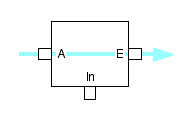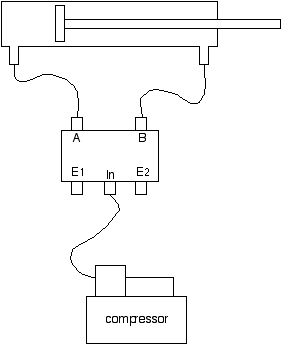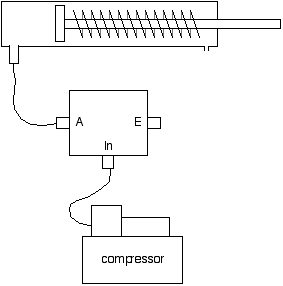 |
|||||||
|
|
Air Cylinders, Solenoids and Plumbingby: Cliff Martin Confused? I know I was when I first started working with pneumatics. After a while I found that it really isn't very hard, its just there seems to be a few specfic parts for any air application you can imagine. Air cylinders, solenoids and their associated parts come in ALL shapes and sizes to accomodate thousands of applications in manufacturing, construction, military, and transportation as well as dozens of other industries. This stuff is used everywhere, from tiny air switches in medical equipment to air brakes in big trucks. All the strange names and terms around pneumatics have evolved through about 100 years of their use in manufacturing. Double acting, four way, quick connect are all terms that were invented to describe (as best as could be) the difference between the parts. Don't let the names discourage you. They're just names. I've used quite colorful terms myself when working with pneumatics, most of which i won't use here... The first thing to remember is: Pneumatics are easy... really! Its all the different names and parts that seem to be overwhelming. But enough about that... on to the fun stuff.
This isn't the place to discuss every different kind of part that's available - it would take hundreds of pages. But what I'd like to cover is the basic things for a haunter to keep in mind when 'playing' with pneumatics. btw - ScaryGuys has a DVD on Pneumatics! Air Cylinders:There's only two main kinds of air cylinders: Double acting, and single acting. They come in all variations, shapes and sizes. Both kinds are useful for haunt work. Double acting cylinders are useful when you need to push in both directions, and single acting cylinders are useful when only a push in one direction is needed. And, sometimes 'in a pinch', you can adapt a double to act as a single, and a single to act as a double. Air cylinders are measured by three main values: "pressure rating", the "bore", and "stroke"
There are lots of calculations to accurately figure the power of a cylinder, but most haunt pop-up applications can be handled by air cylinders in the range of 3/4" to 1-1/2" bore, and 3" to 8" stroke. Power measurements primarily take into account the air pressure (the higher the pressure, the more power); and the bore (the larger the bore - the more power). The power ratings are usually only quoted at maximum pressure. So if a cylinder produces180 pounds of 'push', it will only deliver that at the maximum pressure (usually 250 psi for commerical cylinders). Haunters should work their props at much, much lower pressures than the max pressure. A good goal is not to exceed 60-70psi for working props. Going much higher causes more stress on the prop and all parts in the air system, and makes your compressor run more often. Even at lower pressures, air cylinders can still move very fast and deliver quite a lot push, so always be very careful around pneumatics! Double Acting means the air pushes the rod out, and pushes the rod in. Without air pushing one way or the other, nothing happens!
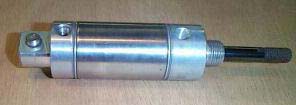 A typical double acting air cylinder
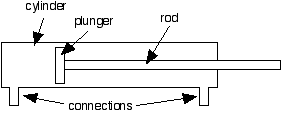
Every double acting air cylinder has these basic parts. A metal cylinder to hold everything together, a 'plunger' that the air pushes against, two connections to get the air in and out, and a rod connected to the plunger that goes in and out. That's it. Here's a simple animation to illustrate the motion...

As air is sent into the left connection (pressure is shown in yellow), it pushes against the plunger and the rod goes out. At the same time, air is released out of the right connection. To reverse the motion, air is sent into the right connection, pushing against the plunger on the other side and the rod is forced back in. The trick to the double acting cylinder is that you have to let air OUT of the other side! This is an important feature of the double acting cylinder, and an advantage that gives you great control over the motion of the rod (but, more on that later!). TIP: the most useful double acting cylinder I've found is one with 1/4" connections, 6"-8" stroke, 1" bore, and end clevis mounts. But that's just me - of course, most any cylinder can be adapted for haunt use! Single Acting means the air cylinder rod is ONLY pushed in a single direction, either out or in. There is only one connection for air, and a little hole in the other end to let air in and out. A spring is used to push the rod in the opposite direction after air pressure is removed.

with the rod normally out without pressure

with the rod normally in without pressure As air is pushed into the connection, the plunger begins to move and compress the spring. Exhaust air exits out the exhaust hole on the other end. When air is released, it exits out the connection, and air is sucked into the exhaust hole as the spring pushes the plunger back to its resting position. Basically, the spring is the 'push' needed to return the plunger and rod back to their starting position. When selecting a cylinder for an application, remember that a double acting cylinder pushes in both directions, while a single acting cylinder only pushes in one direction. MountingThere are about as many ways to mount an air cylinder as there are different types of air cylinders. Again, this is because of all the uses. My personal favorite is the clevis mount. (see photo below) Clevis mounts give the greatest amount of movement, flexibility, and ease of mounting over other mounts. You can adapt one type of mount to another by rigging up an adapter. You'll need to evaluate how to build or buy an adapter - every situation is different. The key thing to remember is that "There is a way!".
 Double acting cylinder with clevis hardware eBayBuying on eBay
is a great way to save money when purchasing air cylinders. Often you
can find air cylinders that include all the fittings and mounting hardware.
This can easily save you $20 in extra parts. I'd recommend not spending
more than $10-$15 for an air cylinder without fittings and mounting hardware,
and certainly no more than $20-$25 for an air cylinder with all the hardware.
(this includes shipping/handling!). There's just too many air cylinders
being sold on the surplus market (eBay sellers) to pay anywhere near retail
for an air cylinder. Read the descriptions carefully, and pay special
attention to the shipping details. Often shipping will be equal to or
more than the purchase price! If the description doesn't match or doesn't
have enough information, DONT buy it! There will be more for sale
tomorrow. The secret to successful purchases is to take your time. Never
buy something because you need it immediately - especially from eBay.
There are folks who have paid more than retail for used equipment because
they got caught up in the 'auction frenzy'. Other SourcesIf you must have a particular air cylinder to fit a need, McMaster Carr, and Grainger are good local places to purchase a variety of air cylinders. Check the phone book, there is probably a local supplier of hydraulic and air equipment in your area. Building a long-term relationship with a local supplier is invaluable when you need advice or help with a sticky problem. SolenoidsHere's the most confusing part of dealing with pneumatics - solenoids (they're also called 'valves', 'air valves', air solenoids', etc.). Just like air cylinders, they come in all sizes, styles, shapes, sizes, and combinations. There's literally something for everyone when it comes to solenoids. TIP: Don't worry about what the solenoid looks like, just what it can do. The whole 'four port', 'five port', 'two way', 'three way', naming comes from the action of the air as it moves through the solenoid. Again, the names aren't as important as what it does. The best combination of flexibility and use for double acting cylinders is what's called a "five port, four way" solenoid. Five Port, Four Way Solenoid
 Five port, four way solenoid A five port solenoid
has just that - five connections called ports. Usually, they are labeled
A, B, E1, E2, and In. There are (of course) variations of this too. In
most cases, any pair of ports that have a label that has an 'A & B',
'1 & 2', 'A1 & A2' - are the ports that connect to the air cylinder.
Exhaust ports almost always have an 'E' in the name. T The 'four way'
term describes the paths that air can take when the solenoid is in operation.
Use the drawing to follow this desription. When a four way solenoid is
'off' or 'deenergized', air will And when the solenoid is 'on', (energized), air pressure from the In port flows to the B port (the third way), and exhaust air is let out of port A through port E2 (the fourth way). An important characteristic of the 5 port, 4way solenoid is called "orifice" size. This is the size of the internal air holes - the internal air paths through the solenoid. Its usually quoted as diameter. An orifice of at least 1/8" is recommended, with a size of 1/4" preferred. The orifice size directly affect the solenoid air flow. The more air it can move, the faster an air cylinder can move. REMEMBER: TIP: The most flexible solenoid for double acting cylinders is a 5 port, 4 way solenoid with a 1/4" orifice. Solenoids come with different voltage ratings also. The most popular voltage is 24 volt DC because that's what most manufacturing plants use, so you'll see lots of them on the surplus market. A 24 volt plug in power supply will easily drive several solenoids. You can find a good selection of wall mount power supplies from Allied Electronics. Four Port, Four WayA variation of the five port, four way solenoid combines the two exhaust ports into one single exhaust. So its called a four port. Its only difference is in the number of exhaust ports. It's used the same as the five port version.
 Example of a four port, four way solenoid Three port, Three
Way
|
||||||
 |
|||||||
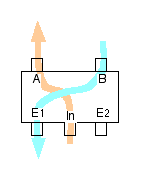 here is almost always a single
'In'. Notice the phrase 'almost always' - that's because there are cases
where solenoids have several sets of in's and out's to fill a particular
application. Ok, that's the 'five port' part...
here is almost always a single
'In'. Notice the phrase 'almost always' - that's because there are cases
where solenoids have several sets of in's and out's to fill a particular
application. Ok, that's the 'five port' part...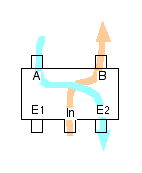 flow through from the In to the A
port (that's one way), and also let out of port B through
port E1 (two ways). So air goes in through the In port,
and out the A port to push the cylinder, and it lets air out of port B
through E1.
flow through from the In to the A
port (that's one way), and also let out of port B through
port E1 (two ways). So air goes in through the In port,
and out the A port to push the cylinder, and it lets air out of port B
through E1.

